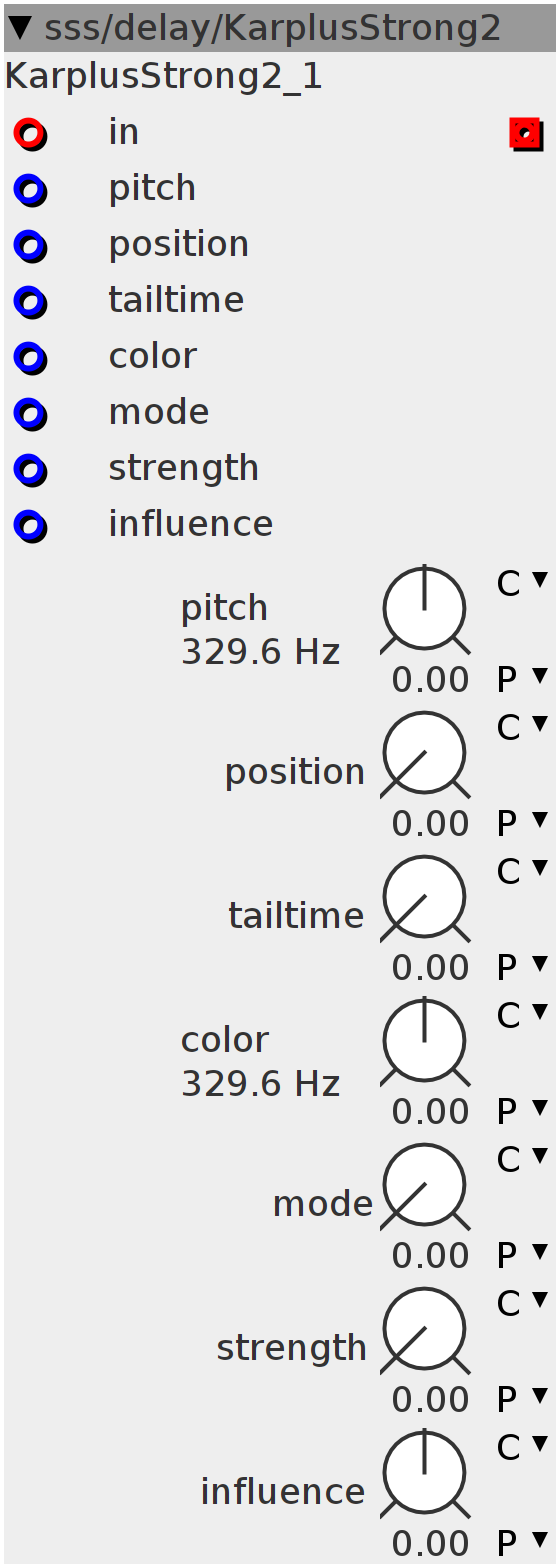KarplusStrong2
Karplus-strong delay tuned to audio-frequencies and a very long decay (depending on dampening-strength) -pitch sets the pitch of the delay-time, tuned to the same pitch as normal oscillators -position sets the "strike" position where the audio enter the buffer (creates two seperate buffer-writing positions) -tailtime sets the time of the tail. 64 is about 40 seconds -color sets the frequency of the "dampening" filter. -mode sets the filter mode: left is lowpass, middle is bandpass, right is highpass. -strength sets the strength of the filtering. At zero, no filtering is applied, at max, lots of damping is applied (6dB per frequency-cycle->that's seriously a lot and very quick to fade out->percussion?) -influence sets the influence by the pitch on the dampening frequency. For a guitar-string, where multiple notes can be played on a single string, this would be around zero, but for a piano, where each keys has it's own three strings with changing materials and thickness between each key, each key will have a different behavior and the higher the key (probably, not sure though haha google knows..) the higher the dampening frequency.
Inlets
frac32buffer delay time (fraction of total delayline size)
frac32 pitch
frac32 position
frac32 tailtime
frac32 color
frac32 mode
frac32 strength
frac32 influence
Outlets
frac32buffer wave
Parameters
frac32.s.map influence
frac32.s.map.pitch pitch
frac32.s.map.pitch color
frac32.u.map position
frac32.u.map tailtime
frac32.u.map mode
frac32.u.map strength
static const uint32_t LENGTHPOW = (13);
static const uint32_t LENGTH = (1 << 13);
static const uint32_t LENGTHMASK = ((1 << 13) - 1);
int32_t *array;
uint32_t writepos;
int32_t feed;
int32_t Time;
int32_t val1;
int32_t val2;
int32_t T1ime;
int32_t lp;static int32_t _array[attr_poly][1 << 13] __attribute__((section(".sdram")));
array = &_array[parent->polyIndex][0];
int i;
writepos = 0;
for (i = 0; i < LENGTH; i++)
array[i] = 0;int32_t pitch = inlet_pitch + 95860818 + param_pitch;
int32_t damp;
MTOF(param_color +
___SMMUL(pitch << 3, (__USAT(param_influence + inlet_influence, 27))
<< 2) +
inlet_color,
damp)
int32_t mode = __USAT(param_mode + inlet_mode, 27);
int32_t strength = __USAT(param_strength + inlet_strength, 27);
strength = ___SMMUL(strength << 3, strength << 2);
float32_t fratio = -pitch;
fratio = powf(2, (fratio / ((float32_t)(12 << 21))));
Time = (((int32_t)((1 << 25) * fratio)) >> 27 - LENGTHPOW);
int32_t tailtime = (param_tailtime + inlet_tailtime) >> 5;
float32_t ratio = (float32_t)(Time) / (float32_t)(tailtime);
float32_t dB = (float32_t)(-10) * ratio;
dB = powf(2, dB);
int32_t DB = (1 << 31) * dB;
DB = DB;
int32_t TIME = (int32_t)((1 << 25) * fratio);
uint32_t tmp_w1 = (TIME << (LENGTHPOW + 3)) & 0x3FFFFFFF;
uint32_t tmp_w2 = (1 << 30) - tmp_w1;
int32_t position = __USAT(param_position + inlet_position, 27);writepos = (writepos + 1) & LENGTHMASK;
uint32_t tmp_di1 = writepos - (Time)-1;
int32_t tmp_a1 = array[tmp_di1 & LENGTHMASK];
int32_t tmp_a2 = array[(tmp_di1 + 1) & LENGTHMASK];
int32_t tmp_r = ___SMMUL(tmp_a1, tmp_w1);
tmp_r = ___SMMLA(tmp_a2, tmp_w2, tmp_r);
lp = ___SMMUL(tmp_r << 3, DB);
val1 = ___SMMLA((((int32_t)(lp)) - val1) << 1, damp, val1);
feed = ___SMMUL(((1 << 27) - (strength >> 3)) << 3, lp << 2) +
___SMMUL(strength, (val1 + ___SMMUL(mode << 3, (lp - (val1 << 1)) << 2))
<< 2);
array[writepos] = -feed;
array[(writepos - ___SMMUL(Time << 3, position << 2)) & LENGTHMASK] +=
inlet_in >> 1;
array[(writepos - Time + ___SMMUL(Time << 3, position << 2)) & LENGTHMASK] +=
inlet_in >> 1;
outlet_out = -feed + inlet_in;